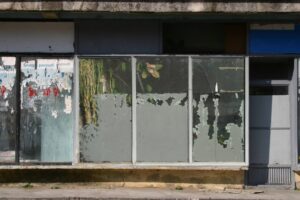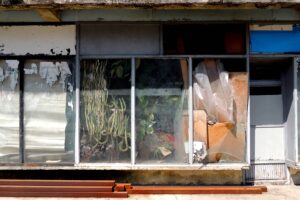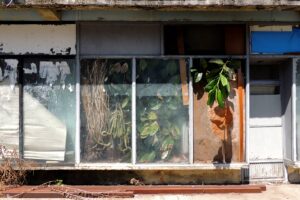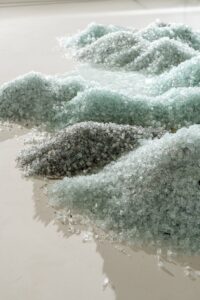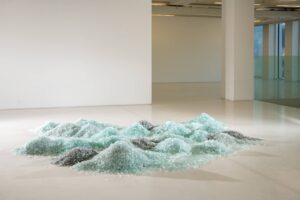Irena Lagator Pejović (1976 Yugoslavia) is a visual artist. She represented Montenegro with a solo show Image Think at the 55th International Art Exhibition – La Biennale di Venezia, in 2013. Other important solo shows include Società a responsabilità limitata, Villa Pacchiani, Santa Croce sull’Arno curated by Ilaria Mariotti (2012); What We Call Real, National Museum of Montenegro (2008); Is It Still Winter, Outside: Museum of Contemporary Art, with Petra Maitz: Lady Musgrave Reef, Banja Luka, B&H curated by Sara Vujković.
A book about her artistic practice, The Society of Unlimited Responsibility. Art as Social Strategy. 2001-2011, was edited at Neue Galerie Graz by Christa Steinle & Karin Buol-Wischenau and published by Buchhandlung Walther König in 2012.
She has exhibited internationally since 2000 at exhibitions such as Reflections of Our Time: MoCA Acquisitions 1993-2019, Museum of Contemporary Art, Belgrade, Serbia (2020); 100 Years of the Bauhaus Contextualizations and Re-Contextualizations of the Bauhaus in The Yougoslav Art Space, Faculty of Architecture and Goethe Institut Belgrade, curated by Miško Šuvaković (2019); D´une Méditerranée, l´autre – FRAC – Provence-Alpes-Côte d’Azur, Marseille, France curated by Francesco Bonami, Emanuela Mazzonis, Pascal Neveux, Ricardo Vazquez (2017); Normalities, Austrian Cultural Forum New York, NY curated by Marko Lulić and Christine Moser (2016); Fiery Greetings, Museum of Yugoslav History, Belgrade / Lothringer13 – Städtische Kunsthalle München curated by Ana Adamović (2015); The Sea is My Land – Artisti dal Mediterraneo, MAXXI, Rome/Triennale di Milano Design Museum curated by Francesco Bonami, Emanuela Mazzonis (2013, 2014); Spring Exhibition, Kunsthal Charlottenborg, Copenhagen (2013); Disappearances, National Gallery of Iceland (2013); Untitled (History), 12th Istanbul International Biennial of Contemporary Art, curated by Adriano Pedrosa and Jens Hoffmann (2011).
Her works are included in collections of public institutions such as: FRAC Marseille, France; Villa Pacchiani (PI), Italy; Museum of Contemporary art in Belgrade, Serbia; Museum of Contemporary art in Banja Luka, Republic of Srpska, B&H, Museum of Money in Belgrade, Serbia, Galery Nadežda Petrović, Čačak, Serbia.
Among her most important awards are Transforming Memory. The Politics of Images, 24th Nadežda Petrović Memorial, Čačak, Serbia (2007) and Reconstruction, 4th Cetinje International biennial, Montenegro, UNESCO Prize for Visual Arts (2002).
She works as an assistant professor at the University of Donja Gorica in the Faculty of Design and Multimedia in Podgorica (Montenegro), and collaborates with the Institute for Contemporary Art in Montenegro (ngo) on the ACB Arhive of Cetinje Biennials project. She lives in Montenegro, in Podgorica and in Cetinje.
Occupying/Liberating Space and Time
C-prints: 2005/2008/2010/2013/2015
70 x 100 cm, each
Exhibitions/Venues:
the sea is My Land – Artisti dal Mediterraneo. MAXXI, spazio D, Rome, Italy. Curated by: Francesco Bonami and Emanuela Mazzonis.
D´une Méditerranée, l´autre – FRAC – Provence-Alpes-Côte d’Azur, Marseille, curators: Francesco Bonami, Emanuela Mazzonis, Pascal Neveux, Ricardo Vazquez.
Photo: Irena Lagator
The piece is in the collection: FRAC – Provence-Alpes-Côte d’Azur, Marseille, France (Regional collection of contemporary art).
Courtesy by exhibition: the sea is My Land – Artisti dal Mediterraneo, curated by: Francesco Bonami and Emanuela Mazzonis.
2005-2015
Occupying/Liberating Space and Time, 2005-2015, is a series of photographs visualizing an ongoing life, but also the relation between human beings, material conditions of their lives and environment. I took these photographs over the course of ten years in an almost abandoned town in Montenegro, Rijeka Crnojevića, whose social, cultural and economic life deteriorated after the construction of a new magistral road in the 80’s between bigger towns in its vicinity i.e. “business” and “cultural” capitals of Montenegro, Podgorica and Cetinje.
In the windows of an abandoned space the only remaining form of life was the collection of plants that grew freely over time. The outside layer of the window glass contains a layer of gray color that had initially been laid on to cover the windows, but that has been removed by the remaining townsfolk day after day, in order to give light and foster life back to the plants. A simple act, in a small deserted town, that takes on a universal significance while exceeding reflections upon societal structures in Montenegro.
I returned at regular intervals to photograph this twofold process that shows a peaceful occupation by the plants from the inside, and simultaneously a poetic liberation by the anonymous passers-by who felt the responsibility to interact with it. In this photographic staging, my intention was to make the freedom of thought and the independence of civil judgment visible, which celebrates and protects non-human forms of life, as well as to discuss the effects of inequalities.
The occupation of space is not just geo-political; it is personal too, if we occupy the lives of others with existential questions fostering displacement of people like it happened here. Therefore, I’m interested in redefining the role of the citizen by showing the importance of her critical presence, perception and awareness of political and economic structures that shape our lives. The question that comes to mind here is how we can modify the meaning of the occupation and escape as processes toward their more inclusive and human version, while celebrating common values and space in the common world. (Irena Lagator)
This is Not a Landscape Any Longer. Tolerance, Transparency, Transition
floor installation, fragments of broken facade glass from the same architectural facility in which the work is exhibited
30x200x200 cm
Exhibition/Venue:
Night in Montenegro and Other Stories, Art gallery “Miodrag Dado Đurić“, 13. November salon, National Museum, Cetinje, Montenegro, curated by Petar Ćuković.
2020
The installation This is Not a Landscape Any Longer. Tolerance, Transparency, Transition stems from my many years of artistic and theoretical research into the history of the edifice of the branch of the National Bank of Yugoslavia in Cetinje, whose author was the Yugoslav architect Petar Vulović.
The installation makes visible the instability and fragility of the current socio-political and ecological moment of local and planetary character through the use of materials in emergence – fragments of broken facade glass from the same architectural facility in which the work is exhibited. The aim of this piece is a critical, but also poetic sensitization of our social being towards the effects of passivity and fragmentation of social responsibility that this piece testifies to. The piece also serves to encourage conversation about the present, about contemporary art while it is happening, especially when it comes to aspects of the landscape as an urban, architectural and environmental factor that continually shapes our perception.
In that process, I depart from Petar Lubarda’s statement “It is not a landscape” which he expressed while talking about his painting “Night in Montenegro” (1951), who, like his contemporary, the architect Petar Vulović while he was conceiving the original version (1960-64) of the bank – our present Art Gallery – was interested in the notions of derivatives and transformations of both the natural and the socio-political moments. I try to point out the potentials of consistent implementation of the process of tolerance and transparency from the local and specific to the current global transition of the Anthropocene, all in order to ask critiquing questions: how to learn from what remains; how to build on ruins? (Irena Lagator)
Tourist Purpose Object. Where is the Monument?
installation, color photography on aludibond, documentation
2020
This hanging photographic installation is a work in progress. Its outside shows uncultivated city vegetation that visualizes spontaneous processes of micro biodiversity to which citizens are often indifferent, because it doesn’t belong to their personal property. Instead, it is part of the public space that is both common and nobody’s at the same time.
The inner side of the installation shows content related to history, memory and the notion of freedom. During the process of building a tourist facility on the Montenegrin coast, a monument to the fallen fighters in the People’s Liberation War of 1941-1945 was discovered, but it was simultaneously covered with the construction materials to be soon even fully removed.
Since the monument stood forgotten in the same place for years because it was covered with dense uncultivated plants, this installation is saving the new but unfortunately brief visibility of the monument, in order to remind us of fundamental cultural and societal values such as freedom.
The installation also shows a document which I addressed to the Ministry of Culture of Montenegro and its Directorate for the Development and Promotion of Activities in the field of Cultural Heritage with a request to answer my question: Where is the monument? Their response, as well as further documentation, will be presented on the occasion of future presentations of this same installation.
The work activates the questions related to environmental, cultural and political instrumentalization by the structural powers in a time when profit-oriented goals ignore historical, scientific and solidarity-oriented processes. Therefore, this work focuses on sensitization of the audience to the critical exploration of the instrumental and hidden powers in society that shape our surroundings and thus our lives at both local and global levels. (Irena Lagator)
